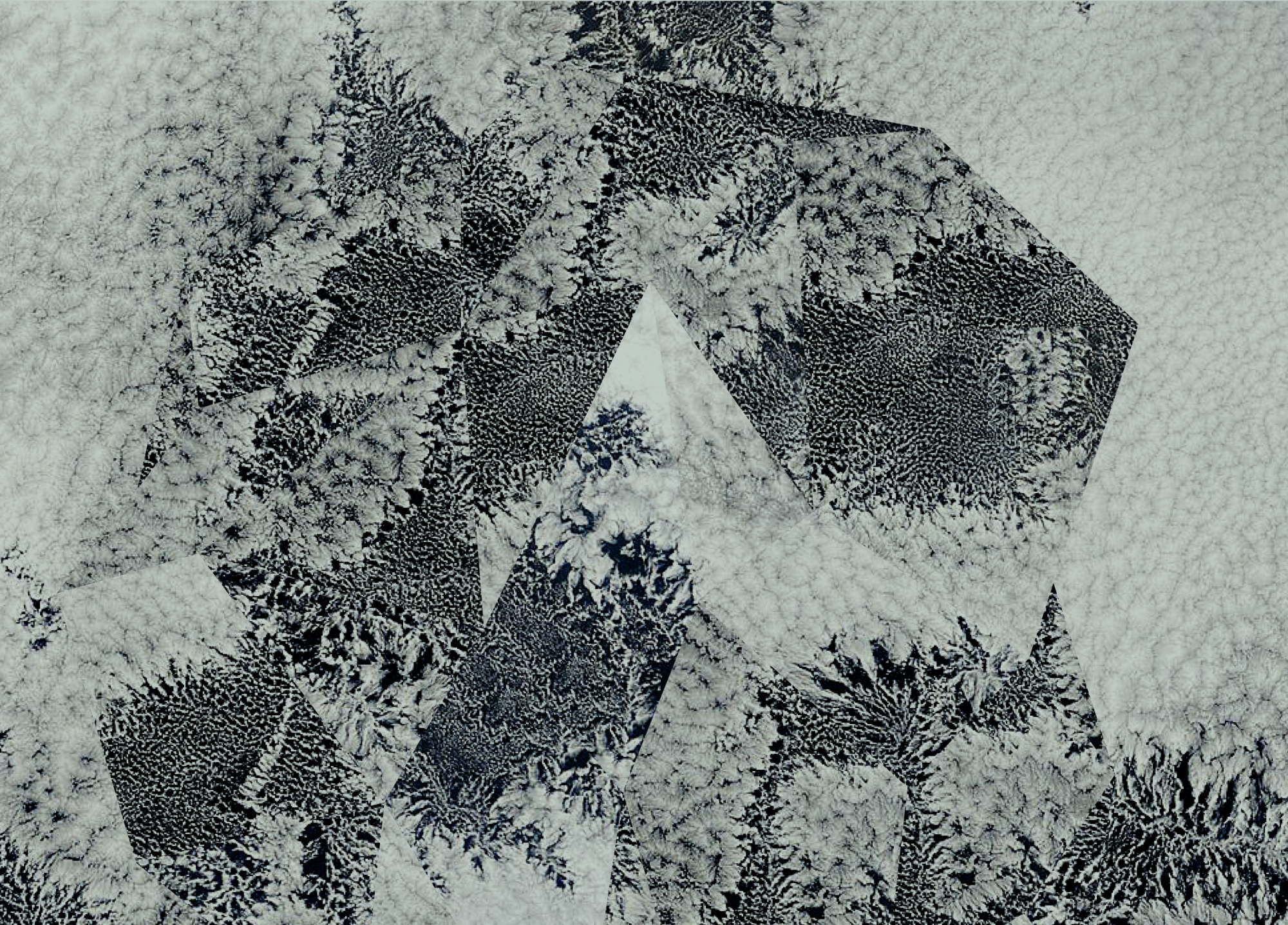The universe is dynamic – always on the move. From clouds of gas and dust, stars coalesce. Water circulates in the ocean in great loops and gyres, driven by differences in temperature and saltiness; convection currents stir up the air and summon up clouds and jet streams. Rivers flow down from the mountains in branching formations like those through which our blood courses. Many of these flows are turbulent – too fast to maintain any constant form or to be fully predictable – and yet that doesn’t strip them of all order.
(Philip Ball, 2016, p.108)
”Li” is a term coined by David Wade in his book ”Dynamic Form in Nature” (Wade, 2007).
It derives from the old Chinese expression ”Li”, which translates to something between ”pattern” and ”principle”. Wade uses the term to describe patterns created by processes in the natural world, which may seem chaotic, but still give the impression of some kind of order or symmetry, like waves, ripples, clouds, patterns of flow in liquids, rivers and so on.
”Li are essentially dynamic formations, and as such can give the impression of a frozen moment, of a process caught at a particular instant of time, or, in a more abstract sense, of the principle of energy engaging with that of form” (Wade, 2007,p. 3)
The Li tend to be relatively simple formations on a macro level, like sand dunes in a desert, which have a clear, repeating character. At the same time the dunes have a high degree of detail and content on a local level, consisting of constantly moving grains of sand.They are dynamic patterns in space and time, expressing how a force works on a material : The sand dunes are formed by the process of wind working on the sand over time, gradually building the dunes.
The Li in Nature are either clearly ongoing processes, like the flow in a liquid, or processes which appear frozen due to their extremely slow movement, like patterns in rock formations, for example. I immediately felt a link to how the processes of improvised music in an ensemble work: The macro form of the improvised music I enjoy playing and listening to most, is often relatively clear cut, yet there is ample variation on a micro level. Improvised music can also be seen as a self-organizing system, where any input has consequences for the overall form, just like in the Li processes and patterns are influenced by the various external forces and conditions working on them.
These properties of the Li made me think that they would be the perfect metaphor to use in my music. They could possess all of the qualities I abstracted from Gugak, and many more, allowing myself and the musicians to associate freely around them, influenced by our previous work together, within the framework of the Li.
My Adaptation of the Li
Nature is constantly moving, dynamic, unpredictable, at times violent and always flowing. Seemingly chaotic, yet somehow ordered. Now, I am not trying to paint a programmatic picture of Nature, but rather let the Li be inspiration for the music in different ways, creating referents and exercises for improvisation, and building blocks for my
compositions. I have tried to enter each of the natural patterns and see how they could correspond to a musical idea, keeping the ones that spoke most clearly to me, or that I connected to how members of the ensemble were playing.
The Li can function on several levels for the musicians, and for me when I compose.They describe textures, rhythmic and cyclical patterns, behaviours or relationships between the musicians.
The reader can refer to the toolbox throughout this chapter if needed, for an overview of the Li.
Search and Reflect
My adaptations of Li are influenced by John Stevens’ book ”Search and Reflect” (Stevens, 1985), which is a classic guide to practicing free improvisation. Here Stevens presents a range of pieces or exercises designed to work for musicians of any level, focusing on specific fundamental musical elements such as rhythm, durations, group interaction and listening, and there are some similarities in my approach to adapting the Li into musical elements. I was lucky enough to hear John Stevens play on several occasions in Stavanger in the early nineties, when he was invited by Frode Gjerstad, and as a young, impressionable musician, I was deeply intrigued by his music.
Search and reflect has been important to me for several years, primarily as a teaching tool, and I feel it touches upon most of the elements of free improvisation that I find important. It was natural to me to take a closer look at Stevens’ approaches to improvisation. I think the way he breaks the music down to it’s smallest building blocks is a useful way to approach free improvisation. One can only either make sound or be silent. Silence has the property of duration, he says, and the interaction of silence and sound produces music. Silence can be though of as the canvas upon which sounds are ”painted”.
In my composed ensemble music, I felt the need to deconstruct the material even more than I had done with the Gugak abstractions, and the Li provide an opportunity to work with basic, archetypal musical elements. I believe it has to do with how to think when one improvises: In a jazz context you can feel the rhythm, listen to the chords, and play your lines within the jazz tune, focusing on harmonic, melodic and rhythmic invention within the framework.
In free improvisation, on the other hand, I need to give a lot more care to the macro form, the texture and the input of the others, as the framework is being created in real time. There really is no way of automating one’s playing in the same way as in many other forms of music, relying on pre-rehearsed material, so I often feel a need to simplify how I think about material when I’m improvising freely: Sound or silence, high or low register, loud or soft, pitch or noise, short or long sounds, certain gestures or physical movements etc.
What I have been trying to do with the Li is to make this semi-predetermined material simple and open enough to the improvisers, so that they can focus on listening and interacting, as well as sculpting the materials to their ideals. At the same time I have the possibility of working with the material, composing temporal structures and inserting other predetermined materials. In this way I try to enter the mix of predetermined material with improvisers from the perspective of how the processes of free improvisation actually work, without disturbing the fragile balance of conditions which need to be in place, for the dynamic system of free improvisation to function properly.
Simplicity
My musical versions of the patterns need to be simple enough to say something clear about texture, behaviours or form, allowing us to appropriate them in a free manner, where the complexity occurs in the sounds and interpretations more than in the instructions or systems. More complex instructions to the improvisers usually leads to less complex music.
The British composer Michael Parsons, quoted in Eno, touches upon this, revealing an important aspect of my approach to the Li:
”The idea of one and the same activity being done simultaneously by a number of people, so that everyone does it slightly differently, “unity” becoming “multiplicity ” gives one a very economical form of notation-it is only necessary to specify one procedure and the variety comes from the way everyone does it differently. This is an example of making use of “hidden resources” in the sense of natural individual differences (rather than talents or abilities) which is completely neglected in classical concert music, though not in folk music.” (Parsons, quoted in Eno 1981)
Now, if the description of the prescribed activity, in this case a Li, is ”vague” or simple enough, I leave room for more chaos, more uncertainty and more surprises and complexity in the resulting music.
Li as Referents
Central to improvisation is the notion of the ‘referent’: The referent is an underlying formal scheme or guiding image specific to a given piece, used by the improviser to facilitate the generation and editing of improvised behaviour on an intermediate time scale. The generation of behaviour on a fast time scale is primarily determined by previous training and is not very piece-specific. If no referent is present, or if it is devised in real-time, we speak of ‘free’ or absolute’ improvisation. This is much rarer than referent-guided, or ‘relative’ improvisation. (Pressing, 1984: 2)
Moving forward from Gugak, I started using the Li as referents for improvisation which were more varied in expression, and had more to do with what type of improvisation the musicians were practicing already, leaving room for their individual expressions. When i had been composing referents in this way earlier, I moved mostly in a kind of jazz idiom, but this time i wanted a more open, yet specialized (or personalized) approach. Allowing them to co-create their own referents, not unlike one would in an actual free improvisation:
When I improvise freely I might, either consciously or subconsciously, create my own constraints for my playing. Working only in a certain register, tempo or timbre, for example. This lets me focus the music, and create a point of gravity or anchor which I can then work from and vary. New ideas can form, and make the music move in an organic way from one point to another. Referents can be ”seeds” which can be developed and varied as they are played, similar to how the process of a composer or an improviser can be.
I have tried to insert this thinking into the ensemble: Mixing the referent-based improvisation with ”referent-free” improvisation, but working with referents that could work aesthetically in the context of our free improvisations.
Abstract, Associative Interpretation of the Li
The Li can be interpreted in several ways. They can, as mentioned, describe patterns or rhythms, textures or behaviours in a concrete way. But they can also be interpreted in a more abstract, associative fashion.
Pressing points out how one can choose to relate to a referent in many ways:
”It may be imitative, metaphoric, allegorical, antagonistic, canonic, contrapuntal, variational or independent, just to mention a few possibilities; and the time scale for behavioral response may vary from very short to long” (Pressing, 1984: 4 )
My initial ideas, when choosing what Li to use for my toolbox, were quite concrete (i.e. ”spots” equals short sounds), or slightly more abstract, as in ”clouds” should have a rolling, turbulent character, while still consisting of groupings of ”particles”. Some musicians will approach them even more abstractly, and ”the feeling of clouds” could be a viable way of interpreting the Clouds Li for some. An axis again, from concrete to abstract interpretations.
Rehearsing the Li
The first approach I use when working with the ensemble, is to try out the Li improvisation exercises.
These exercises allow us to work on the Li patterns together, rehearse listening, behaviours and textures collectively. They also allow us to gather around something concrete in rehearsal, allowing us to have a conversation about abstract music in a concrete, collaborative way. The natural patterns become a manageable simplification of what could go on in an improvising ensemble, and a way of stylizing and developing the materials we use. Later, in concert, we can open more up and take freedoms with the material, building on the experiences we have amassed from working with the Li in rehearsal.
We will work on a Li, for example ”Ripples”, which consists of layered, medium tempo and repetitive sounds. After we have played, interpreting the text, we discuss the results.
How did it sound? Do we agree on the others’ interpretations of the text?
Does it sound good? Should we try one with more or less pitch content?
Faster or slower? Louder or softer?
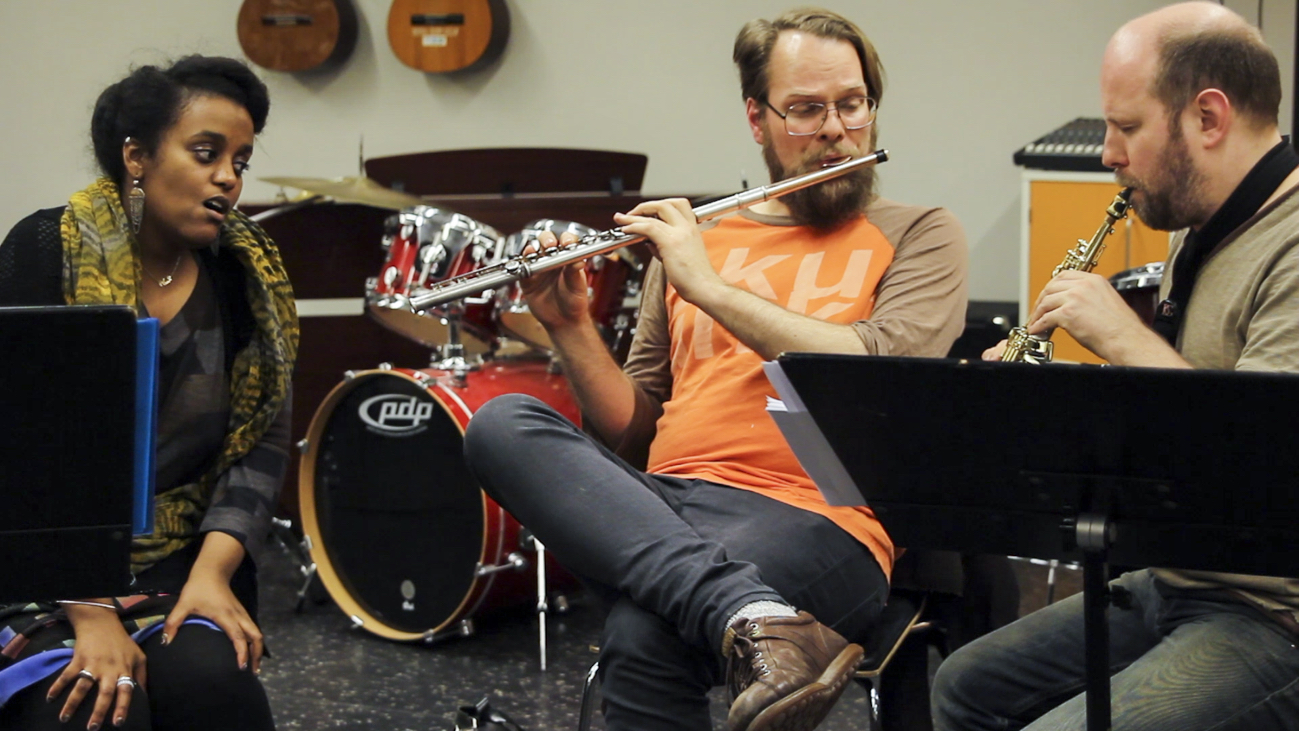
This way, everyone is included in the process, and the hierarchy with me as leader is somewhat played down, allowing for a more collective and collaborative approach.
I will try to encourage as much conversation as possible, and only rarely intervene if I feel we are completely off course. The focus is on the sounding, collective result.
The Li are usually open enough for the musicians to contribute their voice to the mix, so that when they work as referents for improvisation, they will be close to the material that the musicians play when they improvise, their voice, which allows for a blurring of the lines of what is predetermined and improvised, and creates a coherence in the music.
So, by introducing referents into my music, do I make it non-free improvisation again?
Yes, the parts where the musicians are using a referent is obviously referent-based improvisation, and not free improvisation, but again, the referents we use are worked out together to make sure that the musical voice of the improvisers can be heard. They make their choices as to how they choose to interpret my instructions, which makes the sound of our referents close to something they would play in an improvisation. This blurs the lines between what is free improvisation, which I also include in my forms, and what is referent-based.
It also blurs the lines of what can be considered predetermined composition in the ensemble, and I try to play with the amount of creative freedom we have as improvisers:
Sometimes I will assign specific Li to specific people, giving pretty strict conditions but creating a complex texture. There is still freedom to create within this texture, yet the result is similar enough each time to give a clear identity to the music. Other times we use only one common referent, which we develop together without any instructions.
The First Attempt
What happens when I introduce a new Li? How do people react to it? How do we approach it? What are the reactions like?
Sometimes, the first time we play it, a Li works well, possibly because we are able to be spontaneous or simply lucky. When we start discussing a texture or pattern there is usually a period where things get more difficult. A few words can have a great impact when our thought processes meet and are verbalized, and a light, open atmosphere in the group is crucial at this point.
I have my ideas and intentions when introducing a Li, of course, and can get disappointed if it does not sound the way I want immediately. I have learned not to talk too much about the result until we have tried it several times, and I think ideally I should just let the Li develop without any comments, like I would in a free improvisation. Sometimes, because of time constraints, for example in a recording situation, I have to state my intentions with a Li clearly, but I feel that this is a dangerous act. It’s better to let it self-organize, and then be enthusiastic afterwards, when I feel we are in the right place, trying not to intervene unless someone clearly does not understand the idea. Again, I find my position the hierarchy challenging: I will usually be relied on to have the last say, or somehow mold the initial texture or pattern.
Some of the musicians will also expect me to give a clue as to where it should go. If the group is large, I might suggest something to avoid too much hesitation, but my ideal situation is when the musicians provide input, and we can discuss the material in rehearsal. If I don’t agree with their interpretation of my text, I try not to create a situation where I have to tell them not to play in a certain way. The important thing is to give them enough time to feel what the Li could sound like, letting the texture or pattern evolve in the ensemble. Here is an example of a longer version of the ”Ripples” Li, from 2015:
Clichees
A danger of the Li as musical material, especially the ones that are more pattern-oriented (as opposed to behaviour-oriented), is that they can become one-dimensional clichees over time. For this reason it’s important to me to try slightly different versions each time we meet, adding new extra information to them, like ”ripples with air sounds”, ”Spots with pitches”, ”Angles moving from note to noise” etc.
Sometimes I can get the feeling that some musicians are thinking ”oh, this is just typical improv flourishes, how traditional/boring/unimaginative”, whereas others immediately start ”hacking” it, using their fantasy, and the Li as an out of time-referent, for example imagining the sound of actual clouds, their shape, different types of clouds etc, trying to maximize their freedom within the constraints. ”Do they have to be of equal dynamics? How dense could it be? What if I interpret it like this? Can my clouds be longer?”
Luckily, if there is some enthusiasm, the more reserved ones will usually be infected by the mood. This, again, has to do with choosing the right personalities for the ensemble: The musicians have to be open and adventurous enough to join these seemingly naïve games.
Another important aspect of the Li is to understand the limits of how much one can improvise within them before they no longer possess the qualities that gives them their identity. They are dependent on being stretched and subverted, and sometimes they are just seeds for development, but they need to have certain traits to be identifiable from the other Li. This suits some of the improvisers well. Some feel more creative freedom working within certain parameters. Others might find them constraining, and consciously play outside them to make it more interesting.
They are both necessary agents in my music, and I rarely find that the balance is disrupted too much for my taste. It’s not always necessary to adhere to my idea, but it’s important to know when it is important to stick with it, meaning that the ensemble has to understand my process behind the Li. It can also be important to know when the music is best served by not following the initial idea, in situations where my Li ideas need some spicing up.
A variety of interpretations of the Li add more dimensions to the music. However, when composing with the Li, they sometimes need to be very clear, especially when several different Li are playing at the same time, so we tend to be careful that the identity of the Li is preserved, at least in layered sections.
Virtuosity
Virtuosity, showing your dazzling instrumental prowess, must sometimes be sacrificed in a collective musical situation like the PZE. Some improvisers feel a stronger need to play fast, technically difficult passages than others. This does not always work musically in an interactive situation, as too much virtuosity can disrupt coordination in an ensemble (Burrows and Reed 2014).
So do the musicians have to abandon classical virtuosity in order to fit in in the PZE?
Not necessarily, because there is room for that in some of the Li, and some musicians manage to make meaningful contributions even if their voice is based on playing a lot.
However, I think that another virtuosity is more useful: The most important in free improvisation is to be a virtuoso listener, and know what to play at the right time, to make the music sound good together, regardless of background and skill.
Establishing a Group Culture
The way we work with the Li as exercises and referents, in addition to playing the other predetermined material and the larger compositions of Li, lets the ensemble develop a group identity or musical ”culture”, where my Li and other materials influence the musicians.
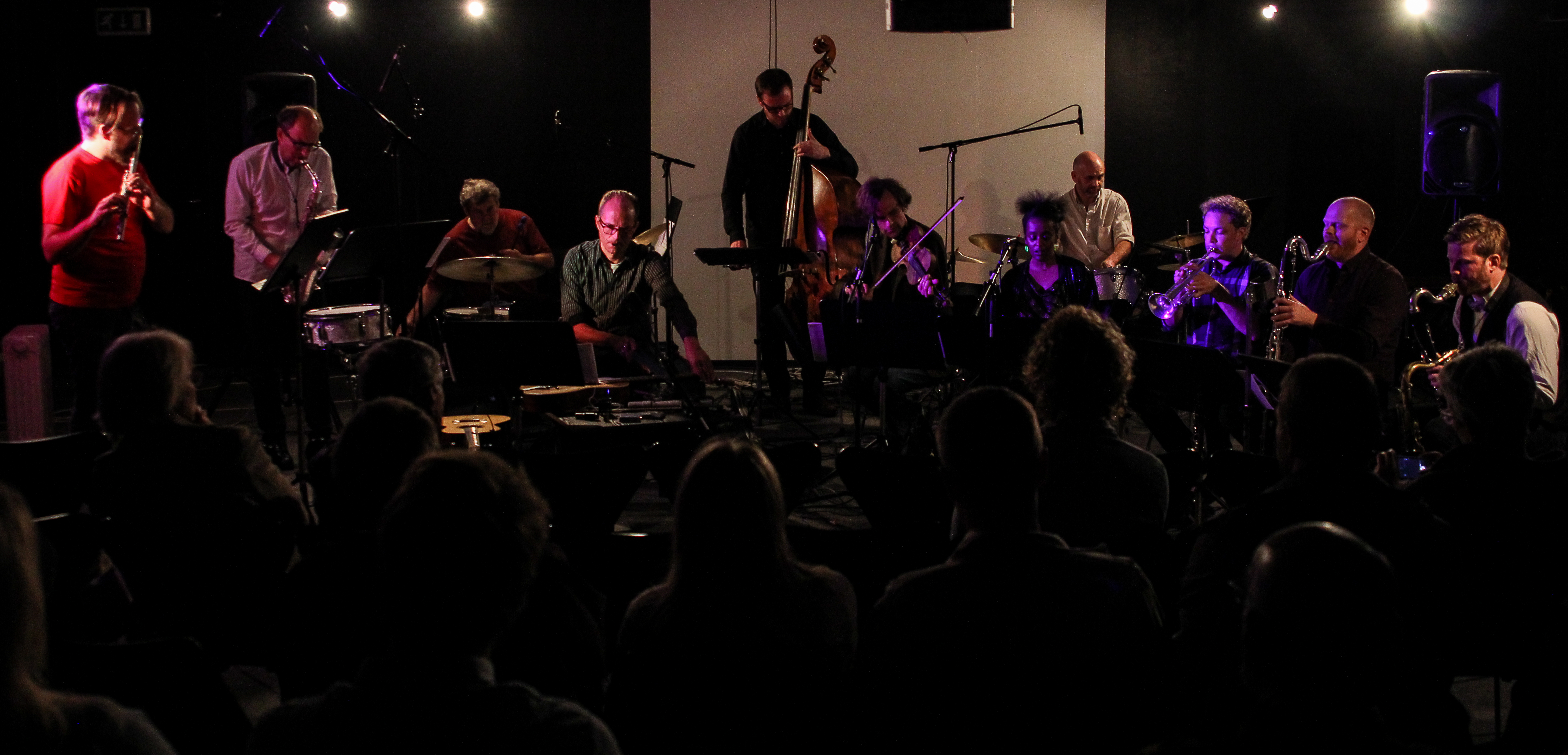 Over time, this practice gives the ensemble a stable identity. In stead of finished works, a method and a culture in this specific ensemble emerges. This method is a way of speeding up what happens naturally in a long-term group, reaching a common understanding and musical identity fairly quickly, which can then be developed and influenced again when it feels necessary.
Over time, this practice gives the ensemble a stable identity. In stead of finished works, a method and a culture in this specific ensemble emerges. This method is a way of speeding up what happens naturally in a long-term group, reaching a common understanding and musical identity fairly quickly, which can then be developed and influenced again when it feels necessary.
When I use the word ”culture”, I mean ”the attitudes and behaviour characteristic of a particular social group” (Oxford dictionary). I am talking primarily about a musical, aesthetic culture within the ensemble, how the improvisers behave and interact musically, what kind of sounds they will prefer, what kind of musical norms and goals we have etc. Similar to an identity and practice a freely improvising group will use years to negotiate tacitly, with rules that are suited to the members.
Of course, the personalities, instrumentation and voices of the improvisers will influence the music, but the ”cultivating” aspect of the Li, and my compositional identity, to be strong enough to be recognizable in two different ensembles, on every level of the music.
My role has changed over the last years, from thinking more about the detail level of the compositions, towards the creation of ensemble culture as an important factor in my composing. I still structure the compositions temporally, and use the Li as material, but the improvisers have taken on a much more important role in the act of creation.
Especially in an ensemble like PZE, where we’ve worked together since the start of the project, the identity and culture of improvisation, and the shared experience of music-making over time, will give conditions, either consciously or subconsciously. This tacit knowledge is based on ”how we do things” in this ensemble, a performance practice, and it is what I aim to influence through the compositions and Li material.
To possibly misuse Coessens’ concept again: We build a common, somewhat scaffold-like and simple, web of artistic practice within the ensemble, which we can develop together:
The culture of the ensemble will naturally also be influenced by every improviser’s web of artistic practice, and the musicians are free to choose how they react to the musical culture: Some will line up with it and some will instinctively oppose it. This is not negative, but gives a dynamic to the music, as long as it isn’t completely subverted and destroyed by everyone at the same time. It’s pluralistic: There should be room for the voice of the individual.
In this example, someone sending a clear message, (in my ears) is Bjørnar Habbestad, who is very expressive after the slow, soft chords in Li 3 before the percussion/flute trio. He modifies his dynamic level after a while, resulting in more dynamics in the form overall.
Another interesting phenomenon is that since the Li are worked out collectively, group dynamics will influence the sounding result to a certain degree. The fact that I have a veto right, is another example that this is a different process than working with a freely improvising ensemble. Yet, if I feel like I have to exercise this right, which happens very rarely, I know that there is something fundamentally wrong with how I’ve approached a situation. I aim to be as non-authoritarian as possible in the rehearsal situation, and I think the process of creating a culture, at least the culture I want, where everyone feels equal, is dependent on this to function.
Transferring the Culture
The more I develop my ideas, and tune them into working well, combined with working regularly together with the ensemble, the closer i feel like we are approaching my idea(l) of culture. I also know the behaviours of the musicians more intimately.
I believe this culture building is transferable, and if i were to start a new project with new people, this forming of culture would happen much faster using the lexicon of techniques i’ve built during the fellowship.
I did get the chance to use the toolbox with one other large ensemble during the fellowship: The Bergen Impro Big Band.
This group is a collective with a changing line up for each project. When I worked with them, the ensemble consisted of 4 guitars, three double basses (including myself) and two electronics players. I enjoyed working with a more electronic, large ensemble: I had done experiments with electronics/synth players earlier in the process, like John Chantler, but never in a larger setting.
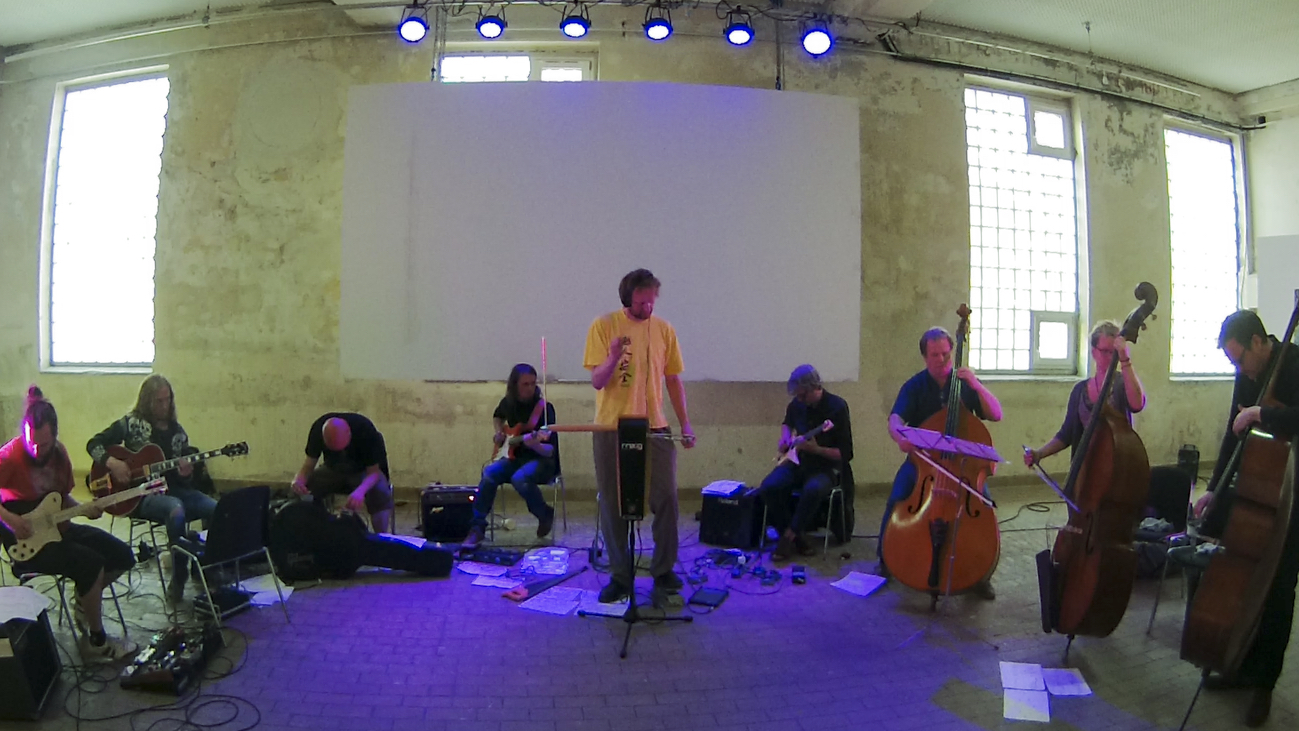
The musicians of the BIBB are on very different levels, some professionals and some amateurs, yet this experience made it clear to me that the Li can be useful to make coherent music, regardless of skill. I was happy with the result, and it made me a little more confident that the Li are a useful way of making music with improvisers. I also had similar experiences doing workshops at UiS, Trondheim (NTNU) and Oslo (NMH) throughout the period.
Bergen Impro Big Band
Composing with Li
Rehearsing Li with the ensemble becomes a kind of material studies for my compositions, like a visual artist or architect would work, but with a living material. I use the Li as building blocks in larger forms, and I have an idea about what they might sound like in the composition, allowing me to work with the improvisers without being completely in the dark as to what will happen when we play.
The Li are inspired by natural patterns in a pretty direct way, but the macro forms I devise come from a more intuitive way of working, not influenced by the ”concept” of Li.
I make a timeline corresponding to the duration of the concert we are about to do, and usually we will play for one hour. This is long enough for the audience, and a format I like working within. I will think about a possible start, an ending, various climaxes, transitions and how different sections contrast each other, and create a form from these materials.
I always include sections of completely free improvisation as well, making sure that all the musicians get to play at least one free improvisation with a small group in a piece. What will happen in the improvisation is of course unknown to me, but I usually give a time suggestion, for example three to five minutes. The real meaning of this time-limit to me, is that the improvisers should not end at the first possible ending, but push through and feel that they have time to play for as long as they want. Three to five minutes seems to be a natural length for an improvisation, in this ensemble, before one feels the need to change the approach and move on to something new. Within a three to five minute section of free improvisation, two-three smaller sections usually materialize.
After playing with the group for a while I realized that I preferred these improvisations to mainly happen in groups of up to three players. When everyone is playing, I usually like to use Li or some other form of organization. The Li then function as clear, unifying parts between the improvised sections and the predetermined notated material, staying within a similar aesthetic or contrasting. If you have to transition from a predetermined part to a free improvised one, there is always a gap between the two cognitive activities of reading and improvising. There is inevitably less focus on listening and a much smaller room for creative expression. The Li bridge this gap, as they are something in between.
Notation
Notation is one of the main visible differences between the process of predetermined composition and improvisation. Notation allows one to fix the methods for composing and preserve them for the future, like in literature. Improvisation is an aural and oral tradition, which relies upon listening and responding to and expressing what you hear, not reproducing what you read.
I have come to the point where I think about my ensemble scores as a map, and the sounding result as the real territory: A much more detailed and unpredictable, ”real” version of what is found on the paper.
Prescriptive and Descriptive
”Prescriptive” notation means notation which tells the musician to perform an action, for example guitar tablature, which does not describe a sounding result, but rather where to place the fingers. Another examples is a tremolo, which does not say which pitch to play, but rather what to do with a pitch.
The other category of notation is ”descriptive” notation: It describes the sound, for example traditional pitch and rhythm notation.
Before the Li, when my main area of focus was Gugak-inspired compositions, I would usually notate the music using a mix of techniques, both ”prescriptive” and ”descriptive”: Pitches, rhythms(descriptive), graphic notation and text (prescriptive).
They way I used graphic notation began to seem, for my use, too imprecise to give any clear information to the musicians, yet too ”visual” to help listening and improvisation. (The only graphic notation I have kept using up until this point, is to show ornaments, or precise rhythmic impulses).
Questions came up during the cycles of rehearsal, such as:
Should this be notated in a simpler or a more specific way?
Will we have time to rehearse it if it’s more predetermined?
Will it be better even if we have the time to rehearse it?
Can it be improvised with the same or a better result?
Can it be improvised in a tutti version without any structuring?
Do I like it better one way or the other?
I felt like the music I was writing was less interesting than what I knew the ensemble was capable of improvising: Less subtle, less poetic, less energetic.
I noticed that the musicians coming from jazz and improvised music, would play with less conviction and energy when faced with a notated score. The ”classical” musicians are able to make good music while reading, but the problem with both groups is that they tend to make the sheet music their main priority when it’s placed in front of them. For some reason the notes on paper becomes the centre of attention and takes on a role as something more important than the communication, the collective sound and the form of the music.
(In some situations, this can have value as a rehearsal strategy, though: Sometimes, after a long, focused rehearsal of Li or free improvisation, a new focal point like a score can give new energy.)
Through this process of creating the music in the ensemble, I discovered that, since the musicians are on very different levels when it comes to reading music, the best way to get more complexity, subtlety and life in the music, was to write less, focusing more on simple texts. I initially tried to use some completely notated pieces for some of the musicians, while others improvised, but I quickly realized that ensemble homogeneity and communication between everyone was more important to me.
Some musicians in the ensemble are of course completely able to read extremely complex notation and keep their focus on listening at the same time. However, I didn’t want a divide between the ”readers” and the ”non-readers”. When I did try it, I saw it leading to a hierarchy or division between the two groups (where both sides seemed to feel like they were on the top of the hierarchy), and what I wanted was a much closer cooperation, listening wise, where everyone was as equal as possible in every respect.
Another idea, which has become more and more important to me, is that since free improvisation is an aural art form (possibly the music that is most dependent on listening of all), composing for free improvisers should have the same aural, or oral, quality. Not a visual, literary one.
I can see a clear development from strict notation to a more and more open way of notation throughout the project, through working with the improvisers. I am presently using mostly text to convey my ideas to the musicians, within a linear score similar to a conventional one. 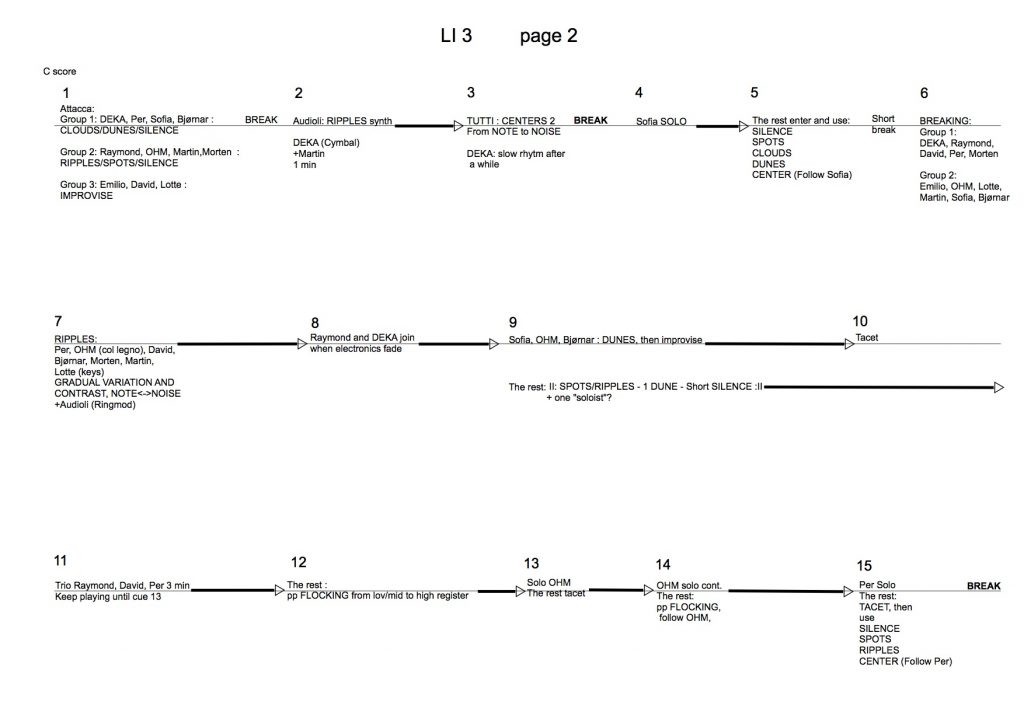
The text Li open up to a more oral/aural way of working, with less emphasis on reading the score. The focus of the performer can be placed on listening, and not be split as much between reading and creating.
Simplifying of the notation has also helped create culture in the ensemble, and a greater feeling of ownership due to the way we have worked out the Li materials together. We have trained ourselves to listen to the same aspects of the music, and work as aurally as possible. The reduction of notational complexity results in a more complex sound, and I think everyone’s voice has more space now.
This goes for my compositional voice as well, although it has changed throughout the project: I think about layering of textures and sound, and I have a more mature idea of what more abstract ideas actually sound like than before.
Evolution of Li
Below are some examples of how the notation of somewhat similar ideas has changed.
Melodic material:
From:
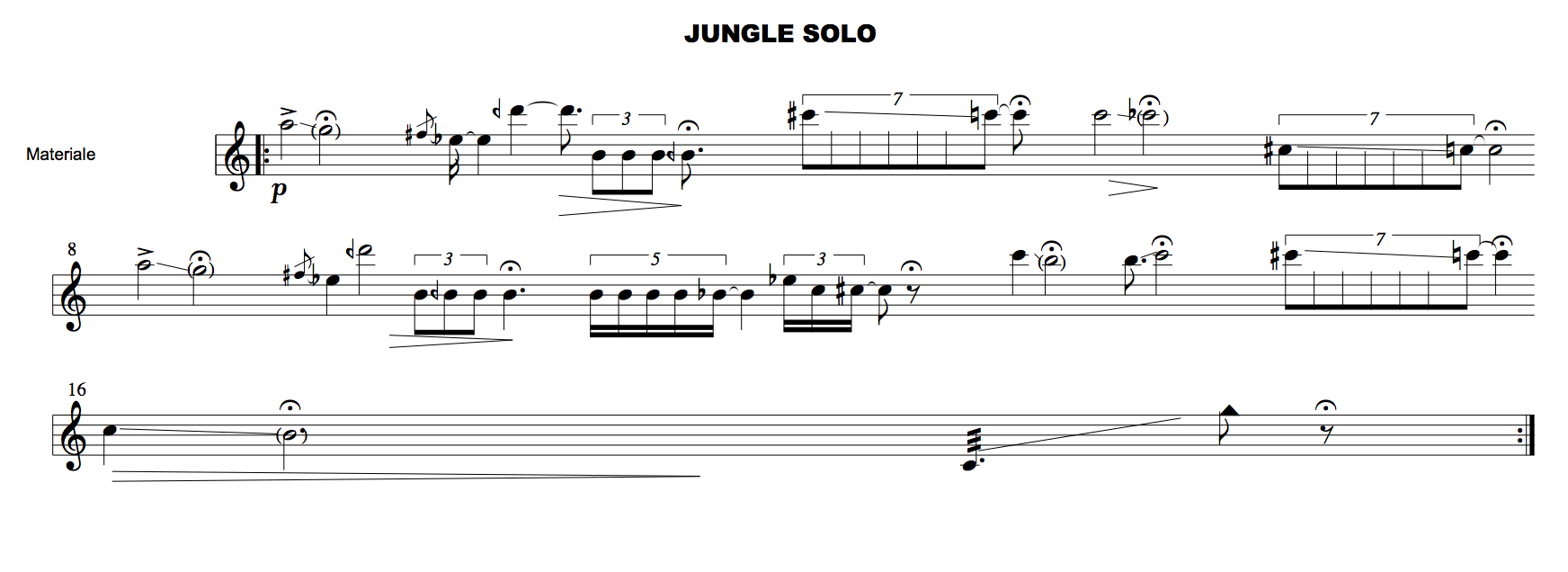
To a Gugak-inspired version:

To the Li version:
Meander
Move from one point to another in a melodic, meandering, linear way, non repetitive.
Rhythm:
From:
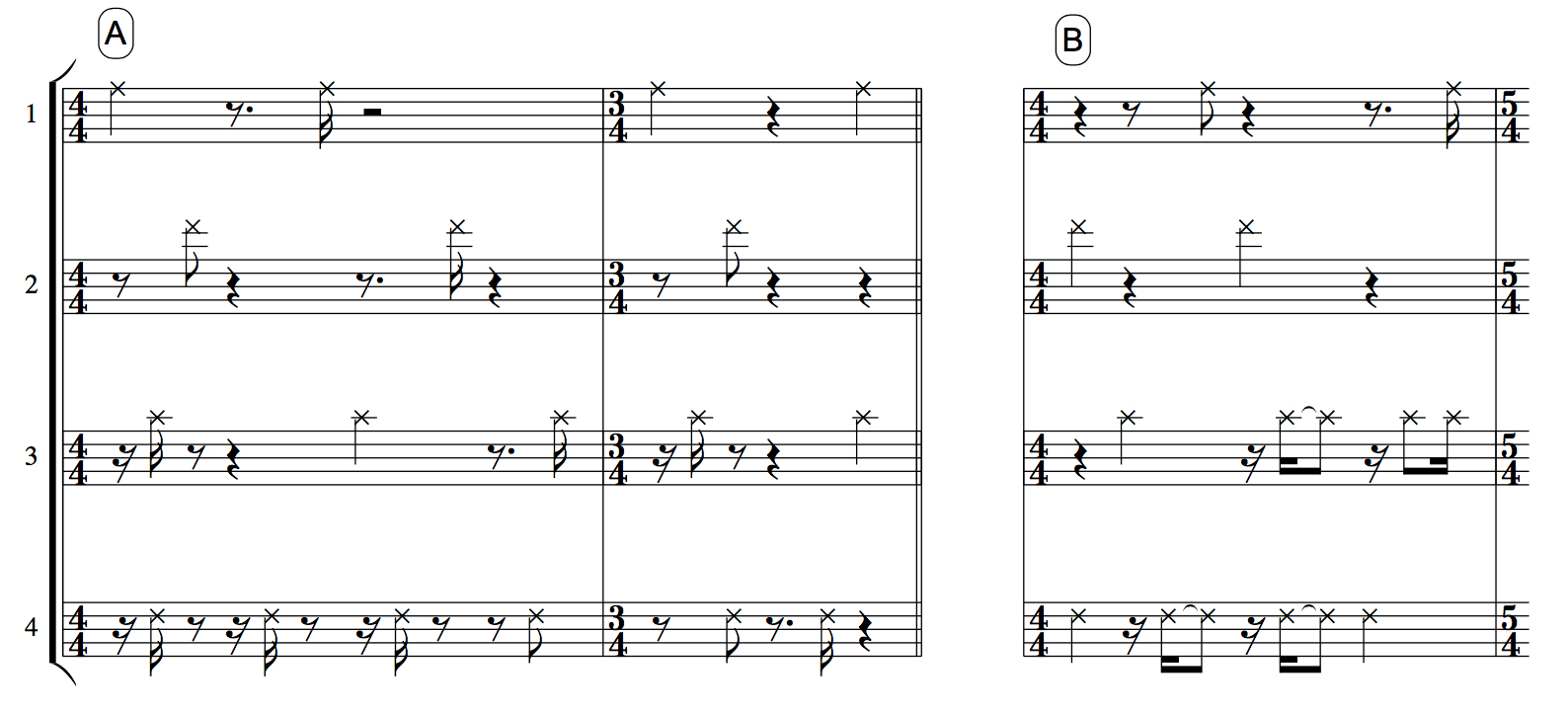
To:

To:
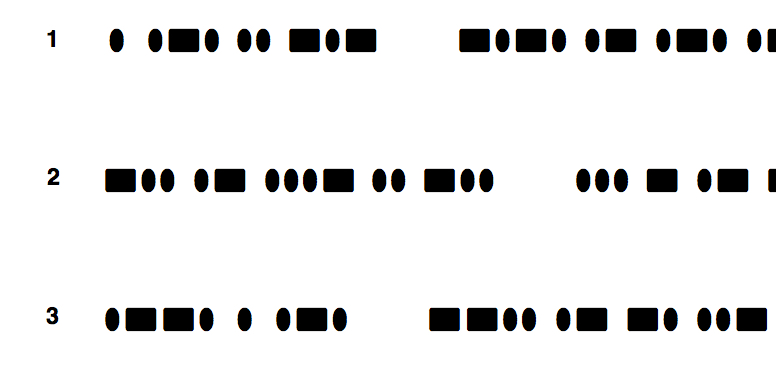
To the Li-version, a percussive version of Ripples:
Ripples 2 (Rhythms):
Repetitive, percussive, polyrhythmic shorter sounds.
Audio ”Notation”
Another form of ”notation” I have been using, are audio recordings at certain places in the pieces. These are usually:
Electronic sounds inspired by the Li made by me
These sounds can be based on various sources (a no-input mixer, Korean shaman bells, modular synth). This example is the sound of a creaking door electronically treated.
Actual sounds of Li
The Li processes in nature are usually silent, very slow or extremely violent sounding.
This sound, however, has a musical quality which I enjoyed: It is the sound of sand dunes moving, producing a ”singing” sound.
Or electronically treated improvisations by parts of the ensemble based on Li.
The process usually looks like this: I bring a Li -> I record a smaller or larger group playing the Li -> I treat the recording electronically -> We play with the resulting audioLi.
Centers AudioLi
I think about these sounds as another way of giving information to the musicians, like a score would, on how to behave musically.
The AudioLi are meant to be played along with by just listening. They ”force” the musicians to listen closely and relate to what they hear directly with no translation through a score or instructions. (This way of working was inspired by the way John Butcher uses audio in his pieces, especially ”somethingtobesaid”. I also heard a concert of Georg Friedrich Haas’ piece ”Introduktion und Transsonation”, where the ensemble plays along with recordings of Scelsi improvising, which interested me).
I will introduce new AudioLi frequently, to keep them fresh in the ears of the musicians.
If we have played an AudioLi for a while, I might also ask the musicians to play them from memory without the audioLi present. Here is an example of the ”creaking door” example from above:
Chinese Whispers
This technique of ”Chinese whispers”, i.e playing from memory, I have also used on my own predetermined material/pieces. Either improvising a version of a piece just after playing it (which is mostly practical to do in the studio), the next day on a tour, or months later. All three situation yield interesting results, and quite often I enjoy the improvised versions more than the originals. The example below starts with an excerpt of a graphically notated piece and moves on to an improvised version.
Pitch-based, circular Li
I sometimes prescribe groups of pitches to use with the Li. These harmonic fields are intended to instigate vertical time, and also to give harmonic clarity and identity in some sections of a performance. They are some of the few gugak-influenced techniques I still use in the ensemble, and are inspired by the way one finds random harmony caused by heterophony in Gugak.
The circular notation indicates that the musicians do not have to move the music anywhere, and lets us focus on timbre, improvising chords and staying in the moment. A typical example of a ”heuristic” way of organizing the mode of pitches and a way of instigating a feeling of vertical time in the ensemble.
Earlier on I would usually write pitches with lines showing the approximate length of each pitch. I still use this approach on occasion, but the circular notation has taken over more and more, leaving more room for self-organization.
ex 9 Centers
The Score
Why a paper score?
Within this field there has been many recent developments regarding the way one makes a score. Video scores on ipads, software generating scores on the fly etc, by artists like Pedro Rebelo, Espen Reinertsen, Justin Yang et. al.
My main interest has been in investigating the sounding results and the communication between the musicians, and I’ve chosen to not focus on making any radical changes in the way I present the score to the musicians.
Originally, I envisioned my scores to be of a more modular character, somewhat like Earle Brown’s scores inspired by Calder’s mobiles. I chose to keep the traditional Linear form of the score (for example in Li 3), with traditional rehearsal signs, because the musicians can read it quickly. It’s a tried and tested form that works in the concert situation, with a minimal risk of misunderstandings, and it gives the order needed to communicate in rehearsal in a large group.
Work vs Process
”What we call a ”work” might better be thought of as a developing structure that arises from the activity of music making” (Benson 2003, 125)
A work is defined as ”A thing or things done or made; the result of an action.”
(Oxford Dictionaries Online)
A process is ”A series of actions or steps taken in order to achieve a particular end.” (Oxford Dictionaries Online)
I have gradually moved away from the idea of producing finished works or ”pieces” during the project period. This way of thinking about musical works, as finite objects with a strong identity, to be preserved and repeated in more or less the same way, seems to me to be too far away from the dynamic and constantly developing nature of free improvised music. I have realized that the process is more important to me. The seemingly fixed nature of the scores I’ve produced, is merely an expression of what kind of music I perceive the ensemble to be making in that very moment in time, and not necessarily how the music should be preserved for posterity. I’d rather build a strong ensemble identity, culture and sound world, which can develop and mutate over time aided by my ideas, than focusing on building a separate sound world with limited materials for each piece. I could have made one piece focusing on only one or two gugak abstractions, for example. And one piece working only with behaviours, one focusing on textural Li etc. These pieces might have had a clearer identity, along the lines of what we associate with “experimental music”, but I wanted all of the toolbox to be available simultaneously, like one has in a free improvisation, at least to me, the composer.
The culture and the toolbox in stead become a method for me for assembling ”works” and frameworks quickly when we have a concert or recording, allowing me to think about the music effectively, and convey the macro form easily to the other musicians.
My identity as the composer of the ensemble’s music comes out in the way I structure our music for each performance, but it’s closely related to my improvising as well. The performances are iterations and variations of the previous music, with new ideas and material added as I see fit. I’m playing in, ”playing” and ”composing” the ensemble simultaneously, in a way. A process in between presenting something to be repeated exactly from the ensemble, or being one of many equal voices in an ensemble. My development as a composer has become more and more closely related to the group process, getting inspiration from the musicians and our improvisations, and the feedback loop between me the composer, me the improviser and the ensemble has become integrated in a way I have not experienced before. The performances and recordings become snapshots of an ongoing process, which to me becomes the work itself.
It’s interesting to me how the work with the Li, combined with a need to do something that would include the musicians more and let them use their own languages and strategies more, made the music sound closer to European free improvisation. Is it less original than my work with only the Gugak inspired material?
Who knows: Both the composer, the composer/improviser and the musicians are happier now, and in the end I think that leads to better music. I am more happy with this music than I was when I had notated more, and this way of working makes me more creative and eager to make new pieces.
Maybe I’ll slide a bit farther back to the left of the continuum now that I know that this, more open, approach works. Maybe now we have the tools to successfully go back and use more melodic, notated materials together with the Li again?
About the Toolbox
Simplifying the building blocks with which I compose allows me to create a number of different configurations/pieces quickly. Since the material is always different, partially created spontaneously and partially orally/aurally in rehearsal by all the musicians, the results can be highly diverse from performance to performance.
Harmonically, the music can also change drastically, by changing the pitches available to the musicians in the more pitch-based Li, and by the fact that pitch is often free for the performer to choose. The instrumentation of improvisers can also be changed, creating even more different outputs with the same toolbox.
By adding instructions to the Li regarding tempo, timbre, dynamics, speed, register and expression, I can develop a rich compositional material in a short time, allowing for great variety from realization to realization of the pieces.
For example:
Ripples with AIR sounds (Li 2)
Angles moving from note to noise over 30 sec (I.e processes within the Li) (Li3)
The toolbox of Li is constantly developing, and will hopefully never be complete, but here is the current list of Li I use to compose with the ensemble. It should be expanded, improved and hacked.This toolbox of Li is in a constant state of flux, and new Li are added all the time.
The Li can be played one at a time, juxtaposed, layered and used as building blocks in larger forms.
I think about the Li as belonging to 3 different categories. Some of them may also belong to several simultaneously.
Textures : A continuous collective sound or texture
Patterns : Rhythmic focus.
Behaviours: Describing behaviours, processes, relationships, modes of action.
I also sometimes use hybrid forms of the Li, mixing several (usually two) of them.
Spots/Ripples f.ex
These can then be layered again within a composition, or have various instructions regarding form. (F.ex Crystallization in Li 3)
They start in two possible ways :
•One person starts, the rest imitate or complement as soon as possible.
•Everyone start together at once on cue, playing from memory/the text, and trying to achieve equilibrium as quickly as possible.
